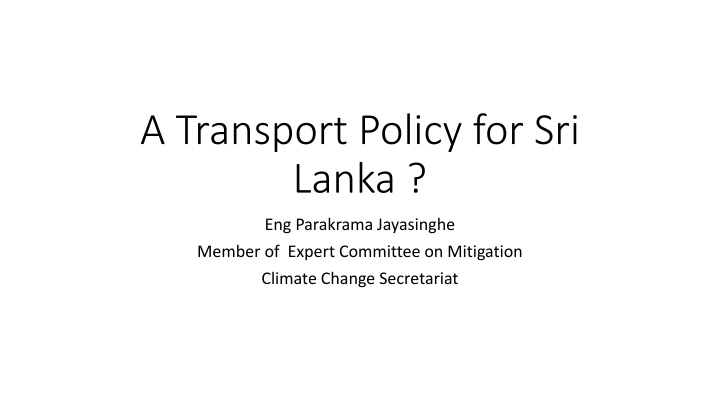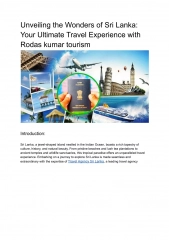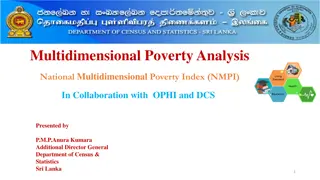Transport Policy for Sri Lanka: Urgent Need for Comprehensive Action
Sri Lanka lacks a coherent national transport policy, leading to various economic and environmental challenges. A comprehensive policy is essential to address issues such as fuel dependency, foreign exchange drain, and pollution. Through detailed studies and stakeholder consultations, visionary decisions can shape the future of transport energy options in Sri Lanka.
Download Presentation

Please find below an Image/Link to download the presentation.
The content on the website is provided AS IS for your information and personal use only. It may not be sold, licensed, or shared on other websites without obtaining consent from the author.If you encounter any issues during the download, it is possible that the publisher has removed the file from their server.
You are allowed to download the files provided on this website for personal or commercial use, subject to the condition that they are used lawfully. All files are the property of their respective owners.
The content on the website is provided AS IS for your information and personal use only. It may not be sold, licensed, or shared on other websites without obtaining consent from the author.
E N D
Presentation Transcript
A Transport Policy for Sri Lanka ? Eng Parakrama Jayasinghe Member of Expert Committee on Mitigation Climate Change Secretariat
An urgent Need due to many aspects Sri Lanka has no transport policy Many discussions have taken place with no coherent national policy accepted and adopted to implement A proper Transport Policy would have a direct impact on the Economy Environment Balance of Payment Social well being Insulation on future shocks
A much detailed an in depth study is needed, But an important step can be taken urgently ! A comprehensive transport policy can emerge only after a detailed study and widespread consultation with all affected stake holders However, correct decisions made under present circumstances could have a positive or negative impact on such a policy even if such effort is made Some visionary practical decisions can be made at present focusing on the events in the recent years both locally and internationally in the areas of technology, finances, balance of payment issues, world and social political scenarios This is in the area of future Transport Energy Options for Sri Lanka
The current Status on Transport fuels Nearly 100 % dependent on imported fossil fuels Highly volatile costs totally out side our control Major cause of continued drain in Foreign Exchange up to $ 4,000 Million annually on fuel imports only. This can only increase Major contributor to atmospheric pollution in Colombo and other cities. ( The positive change was seen during Covid and later fuel shortages) Un accounted additional drain on import of spares Very heavy expense to vehicle users on initial capital, fuel and maintenance. Large increase in inefficient modes of vehicles with very low transport efficiencies such as 3W and private cars Cause of massive road congestion.
LOCAL SCENARIO LOCAL SCENARIO Vehicle Fleet in Sri Lanka Average usage and fuel economy Vehicle Type Cars- Gasoline Cars- Diesel Dual Purpose- Gasoline Dual Purpose- Diesel Buses - Diesel Lories - Diesel Motor Cycles - Gasoline Motor Tricycles - Gasoline Average km/yr 8,000 15,000 8,000 21,000 41,000 52,000 6,225 12,000 Fuel Economy (km/l) 7.5 11.0 6.0 8.3 3.2 3.5 23.5 19.0 Fuel Economy: Liters per Passenger km Bus : 0.01 liter/passenger km Car : 0.05 liter/passenger km 3 W : 0.04 liter/passenger km 2 W : 0.02 liter/passenger km Fuel Consumption in Transport Sector: Gasoline : 400 Million liters Diesel : 1200 Million liters
Transportation is main consumer of Transportation is main consumer of petroleum fuels petroleum fuels Petroleum Usage in PJ Commercial and HH 12% Industry 4% Power Generation 21% Transport 63% Sri Lanka Oil Demand Forecast Source: SEA 6000 160 Petroleum Import Cost (Millions US$) 140 5000 120 Oil Demand 000' bpd 4000 100 Source - Sri Lanka Energy Balance 2018 3000 80 60 2000 40 1000 20 0 0 1995 2000 2005 2010 2015 2020 2025 2030 Cost mm$/year Oil demand Source: CEYPETCO
What led to the present mess The share of public transport has continually deteriorated without any effort for correction. A lot of talk and discussions not resulting in any viable actions Electrification of rail to attract more passengers off the road not implemented The political support for more and more three wheelers has added to the congestion , ostensibly supported in the interest of poorer passengers, not admitting the lack of effort to provide good public transport, which was available in the past, destroyed by irrational and unplanned, unregulated privatization Pushing the people to somehow get a personal vehicle causing many to financial dangers and unsustainable debt commitments The policy statement in the National Energy Policy Gazetted in Aug 2019 stating that 25 %of Light vehicles will be EVs by 2023 under lines the lack of validity and value of such policy documents
Positive Trends making a change viable in short term The crisis of covid and lack of FOREX caused the banning of imports, which must be looked at positively making it possible to charter a different path for the future Sri Lanka already has more than enough light vehicles . Any more additions will exacerbate the road congestion which has reduced the average speed on Colombo roads to less than 12 km/hr. Have saved over $ Million spent annually on import of vehicles which only helps a minority of traders at great financial and economic loss to the country The change over to more efficient and environmental friendly . Far more economical to operate and devoid of any need for imported fossil fuels is now possible and commercially proven world over. Only miniute acceptance in Sri Lanka
Why EVs The main reason for the change over is to save $ 4,000,000 foreign exchange on transport fuel The zero emission form EVs will automatically provide the means of achieving the target set by the NDA on transport. Much lower cost of operation to the owner with 80% energy effcienty Vs 15% for Petrol or Diesel Machines. Cost is as low as Rs 2.50 per km by charging at off peak hours from the grid or near zero if charged using solar power Much lower cost of maintenance reducing the drain oon foreign exchange for import of spares. Most importantly possibility of creating a local industry for converting over 3 Million light vehicles including 3 W and cars to EVs by competent local technicians without the need for new additions from abroad. This has already been commenced by David Peiris and Code Gen All major automobile manufacturers have made plans to stop making and petrol or diesel vehicles by 2035. Many countries have set time targets to reach 100% fossil fuel free transport
What about the larger vehicles? For the near future they would need to be continued on fossil fuels. But the possibility of converting the existing vehicles to run on Green Hydrogen generated using renewable energy is already proven . An increase of efficiency over % is possible with concurrent reduction of carbon emissions. The busses used for public transport can be EVs in the short term. The current higher cost of EV busses can be recovered in a few years by the savings in fuel costs. Railways offer a much more attractive option. Over 90% of our locomotives are actually run on electricity being Diesel Electrics. They can be converted to run the diesel generators on Green Hydrogen generated by the SLR on its own using Solar or Wind at their own depots. This will remove the need for expensive electrical over head electrical supply lines and make all routes to be electrified immediately .
Impact on Transport Cost across the board Transport is major cost for all segments of the economy and for the people. The elimination of use of fossil fuels at ever increasing costs and paid for in Dolars will immediately reduce the cost of transport The change over in Railways will have the most impact by reducing cost of fuel for SLR making them profitable to enable other investments to attract more passengers and cargo. The change is not limited to few corridors , but can be implemented island wide. The reduction in emissions will enable targeting low cost funding from Green Carbon Fund
Converting the Drain to a Spin Cost of Fuel Imports for Electricity and Transport US $ 5000 Million and will continue to increase The Burden The Burden Convert to a Boon CERS CERS Cost of Energy and other imports Value of Energy and local inputs Draining the Economy 3/12/2025 12 Catalysing the Economy !!
Barriers to the change The first barrier is the lack of understanding of the transport authorities, who have not even bothered to draft and implement a National Transport Policy taking into account the ground shaking changes in technologies and innovations in recent years. There would be many barriers created by the small group of people who thrive on dependence on fossil fuel driven vehicles both for import of vehicles, spares and the fuel itself. The larger as interest of the country must prevail over such narrow limited interest. They would try to portray false arguments such as economic revival by relaxing imports of vehicles, ignoring the very negative impact on the BoP and thus driving up the Parity rate. It is the economies of the countries making the vehicles and supplying the fuel that would thrive not Sri Lanka The major saving of foreign exchange must be the main driver.























